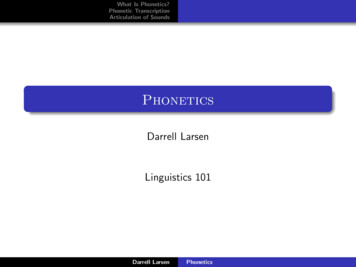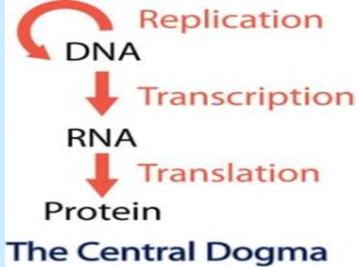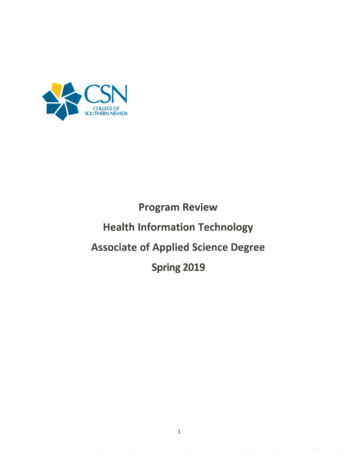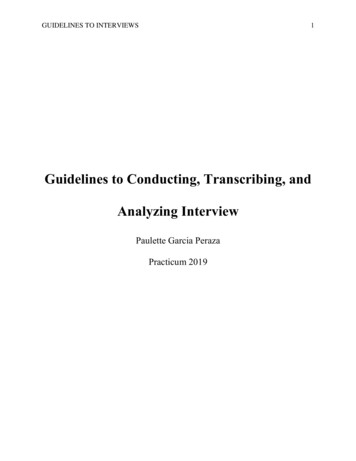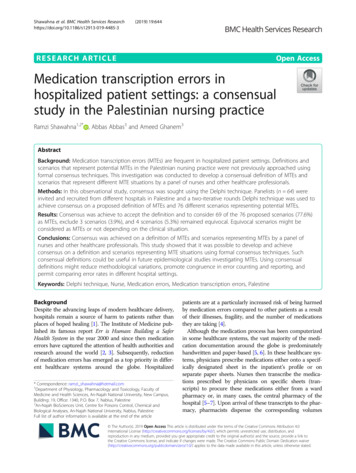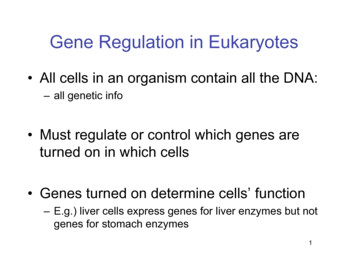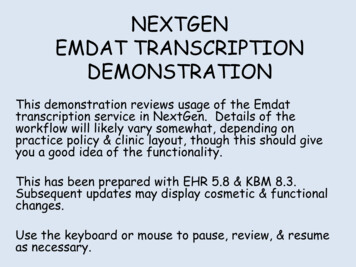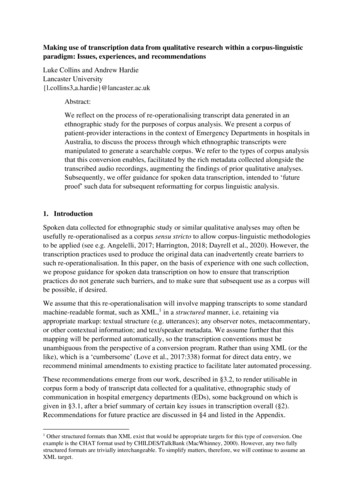
Transcription
Transcription in eukaryotesChromatin structure and its effects on transcriptionRNA polymerasesPromotersGeneral Transcription FactorsActivators and RepressorsEnhancers and Silencers
Order of events leading to transcription initiationin eukaryotes at a specific promoterCRCThe order of steps on the pathway to transcription initiationappears to be different for different promoters
Alteração estrutura cromatinaActividade génicaACETILAÇÃO DE HISTONASCOMPLEXOS DE REMODELAÇÃO DA CROMATINA (CRC)Lys menor ligação do DNA às histonas nos nucleossomasAcção concertada de:-Activadores/ repressores ( proteínas auxiliares acessórias)-Proteínas de remodelação da cromatina-Capacidade de ligação dos factores gerais da transcrição
HistoneacetylationHistone acetylation is characteristicof actively transcribed chromatinInteraction with other histonesand with DNAHAT- histone acetyltransferaseHDAC- histone deacetylase
Chromatin Remodeling Complexes (CRC)orNucleosome remodeling factorsATPase/Helicase activity andDNA binding protein motifs
Local alterations in chromatin structure directed by eucaryoticgene activator proteinsHistone acetylation and nucleossome remodelinggenerally render the DNA package in chromatinmore acessible to other proteins in the cell, includingthose required for transcription initiation.Specific patterns of histone modification directlyaid in the assembly of the general transcriptionfactors at the promoter.Enzymes that increase, even transiently, the acessibility ofDNA in chromatin will tend to favor transcription initiation
Position effects on gene expressionin eucaryotic organismsThe yeast ADE2 gene at its normal chromosomallocation is expressed in all cellsThe ADE2 gene codes for one of the enzymes ofadenine biosynthesis,and the absence of theADE2 gene product leads to theaccumulation of a red pigment
How DNA methylation may helpturn off genesThe binding of gene regulatory proteins and thegeneral transcription machinery near an active promoter mayprevent DNA methylation by excluding de novo methylases.If most of these proteins dissociate from the DNA,however, as generally occurs when a cell no longer producesthe required activator proteins, the DNA becomes methylated,which enables other proteins to bind, and these shut down thegene completely by further altering chromatin structure.Methylation prevents acetylationMetylated sequences recruits deacetylases
Transcrição procariotas vs eucariotas PROCARIOTAS EUCARIOTAS– 1 RNA polimerase– 3 RNAs polimerases– Reconhecimento do promotorpela própria RNA polimerase(coadjuvada pelos factoressigmas)– Necessidade de factoresgerais de transcrição para oreconhecimento do promotor– Região do promotor maisrestrita– Transcritos mono- oupolicistrónicos– Região do promotor maisextensa– Estrutura dos genes maiscomplexa– Transcritos monocistrónicos– Não existência de transcritosprimários– Processamento de transcritosprimários: Modificações em 5 e 3’ splicing
Three RNA polymerases in eukaryotes(28S, 18S and 5.8S)**1*- hnRNAs (heterogeneous nuclear RNA)*1- 5S rRNAEach RNA polymerase is constituted by several subunits (Rpb)
The promoters of genes transcribed by RNApolymerase II consist of a core promoter and aregulatory promoterDPEBREInr(basal promoter)orUpstream promoter elementNot all the consensus sequences are found in all promoters
RNA polymerase IIconsensus sequences(íncluding core andupstream promoter elements)in promoters of threeeukaryotic genesDifferent sequences can be mixed and matchedto yield a functional promoter
RNA polymerase I sequence promotersClass I promoters- are not well conserved in sequence from one species to another- they have a AT-rich initiator (rINR) conserved sequence, which surrounds the transcription start site- the general architecture of the promoter is well conserved-45Upstream promoter element(UPE)GC% richCore elementspacing between these two elements is important 20
RNA polymerase III sequence promoters or Class III promoters-the classical class III genes (tRNAs, 5S rRNA) have promoters that lie wholly within the genes- the nonclassical class III genes (snRNAs) resemble those of class II genesOCT and PSE are consensussequences that can be alsopresent in RNA polymerase IIpromotersRNA polymerase III recognizesseveral different types ofpromoters
Preinitiation complexGeneral Transcription FactorsTFIIATFIIBTFIIDTFIIETFIIFTFIIHCombine with RNA polymerase II to form a preinitiation complex,which is competent to initiate transcription as soon asnucleotides are availableTFIID is a complex protein containng a TATA-box-binding protein (TBP)and a 8-10 TBP-associated factors (TAFs)TBP is a universal transcriptional factor required by all three classes of genes
Assembly of the RNA polymerase IIpre-initiation complexThe first step in assembly of the pre-initiation complexis recognition of the TATA box and possibly theInr sequence by the TATA-binding protein (TBP),in conjunction with the TBP-associated factors (TAFs).Y-S-P-T-S-P-S26x up to 52xThe C-terminal domain (CTD) of the largest subunit of RNA polymerase II,must be phosphorylated before the polymerase can leave the promoter, and start transcription
Functions of human GTFs(General transcription factors)GTFFunctionTFIID (TBPcomponent)Recognition of the TATA box and possibly Inr sequence; forms aplatform for TFIIB bindingTFIID (TAFs)Recognition of the core promoter; regulation of TBP bindingTFIIAStabilizes TBP and TAF bindingTFIIBIntermediate in recruitment of RNA polymerase II; influencesselection of the start point for transcriptionTFIIFRecruitment of RNA polymerase IITFIIEIntermediate in recruitment of TFIIH; modulates the various activitiesof TFIIHTFIIHHelicase activity responsible for the transition from the closed toopen promoter complex; possibly influences promoter clearanceby phosphorylation of the C-terminal domain (cinase activity) ofthe largest subunit of RNA polymerase IIGTF- dictate the starting point and direction of transcription (low level of transcription)
Transcriptional activation by recruitmentTFIID contains TBP (TATA-box-binding protein)plus up to 12 TBP (TBP-associated factors)RNA polymerase holoenzyme contains at least 12 subunitsThe transcriptional activator protein binds to its target site,an enhancer sequence in the DNA and causes recruitment of the transcriptional apparatusby physical contact with a subunit in the TFIID complex.TBP makes contact with the TATA box and also recruitsthe holoenzyme to join the transcription complexFully assembled transcription complexis ready to initiate transcription
Example of transcriptional activation during Drosophila developmentThe transcriptional activators are bicoid protein (BCD) and hunchback protein (HB)dteaics ssoFaTA BP(Ts)ortcfa
Transcription initiation by RNA polymerase II in aeucaryotic cellTranscription initiation in vivo requires the presence of transcriptional activator proteins (coded by gene-specifictranscription factors).These proteins bind to specific short sequences in DNA. Although only one is shown here, a typical eucaryotic genehas many activator proteins, which together determine its rate and pattern of transcription. So they control the expression of theirgenes.Sometimes acting from a distance of several thousand nucleotide pairs, these gene regulatory proteinshelp RNA polymerase, the general factors, and the mediator all to assemble at the promoter.In addition, activators attract ATP-dependent chromatin-remodeling complexes and histone acetylases.
Categories and general structure of activatorsTwo functional domains:- DNA-binding domainZinc containing modulesHomeodomains- transcription-activating domain. may also have a dimerization domainIndependance of domainsof activatorsAcidic domainGlutamine-rich domainProline-rich domainex. GAL4 activatorNH2405094COOH(dimers have increased affinity to DNA)DNA-BDDimerizationdomainADDOMAIN- independent folded region of a proteinMOTIF- part of a domain that has a characteristic shape specialized. Ussually corresponds to an aa sequence
Início da transcrição em eucariotas Formação não muito eficiente do complexo de pré-iniciação datranscrição A formação do complexo de pré-iniciação tem de ser auxiliada(activada) por proteínas adicionais:– Activadores constituitivos (activos em muitos genes; não respondema sinais externos)– Activadores reguladores ou induzíveis (específicos para um nºlimitado de genes e respondem a sinais externos) ACTIVADORES (activators, enhancer-binding proteins, transcription factors)––––Proteínas de ligação ao DNAEstabelecem interacções proteína-proteínaInfluenciam a velocidade da transcriçãoEstabilizam ou estimulam a formação do complexo basal
The modular structures of RNA polymerase II promoterand enhancers: the human insulin geneMultiple enhancers enable a gene to respond differently to differentcombinations of activators.This arrangement gives cells, in a developing organism,exquisitely fine control over their genes in:- different tissuesor at-different times
How regulatory DNA defines the succession of geneexpression patterns in developmentDifferent arrangements of regulatory modules
The cluster of β-like globin genes in humansThe large chromosomal region shown spans100,000 nucleotide pairs and contains the fiveglobin genes and a locus control region (LCR).Embryonic yolk sacYolk sac and fetaliverBone marrowEach of the globulin genes has its own set ofregulatory proteins that are necessary to turnthe gene on at the appropriate time and tissueChanges in the expression of the β-likeglobin genes at various stages of humandevelopment.Each of the globin chains encoded by thesegenes combines with an α-globin chain toForm the hemoglobin in red blood cells.
Model for the control of the human β-globin geneRegulatory proteins thought to control expression of the gene during red blood cell development- CP1 is found in many types of cells- GATA-1 is present in only a few types of cells including red blood cells; thereforeare thought to contribute to the cell-type specificity of β-globin gene expression5’3’Several of the binding sites for GATA-1 overlap those of other gene regulatory proteins;it is thought that occupancy of these sites by GATA-1 excludes binding of other proteins
Induced expressionConstituitive expressionThe modular structures of RNA polymerase II promotersCore promoter modules:– TATA box (consensus 5 -TATAWAW-3 , where W is A or T)– Inr sequence (consensus 5 -YYCARR-3 , where Y is C or T, and R is A or G).Basal promoter elements are modules that are present in many promoters and set the basal level oftranscription initiation, without responding to any tissue-specific or developmental signals:– CAAT box (consensus 5 -GGCCAATCT-3 ), recognized by the activators NF-1 and NF-Y– GC box (consensus 5 -GGGCGG-3 ) recognized by the Sp1 activator– octamer module (consensus 5 -ATGCAAAT-3 ), recognized by Oct-1.Response modules are found upstream of various genes and enable transcription initiation torespond to general signals from outside of the cell:– the cyclic AMP response module CRE (consensus 5 -WCGTCA-3 ), recognized by theCREB activator– heat-shock module (HSE) (consensus 5 -CTNGAATNTTCTAGA-3 ), recognized by HSP70and other activators– serum response module (consensus 5 -CCWWWWWWGG-3 ), recognized by the serumresponse factor.Cell-specific modules are located in the regulatory regions of genes that are expressed in just onetype of tissue:– erythroid module (consensus 5 -WGATAR-3 ) which is the binding site for the GATA-1activator;– pituitary cell module (consensus 5 -ATATTCAT-3 ), recognized by Pit– myoblast module (consensus 5 -CAACTGAC-3 ), recognized by MyoD– lymphoid cell module or sB site (consensus 5 -GGGACTTTCC-3 ), recognized by NF-sB.Note that in lymphoid cells the octamer module is recognized by the tissue-specific Oct-2activator.Modules for developmental regulators mediate expression of genes that are active at specificdevelopmental stages. Two examples in Drosophila:– Bicoid module (consensus 5 -TCCTAATCCC-3 )– Antennapedia module (consensus 5 -TAATAATAATAATAA-3 ).
Integration at a promoterCOMPETITION between activators and repressorsMultiple sets of gene regulatory proteins can work togetherto influence transcription initiation at a promoter.It is not yet understood in detail how the integration of multiple inputs is achieved,but it is likely that the final transcriptional activity of the gene results from acompetition between activators and repressors that act by different mechanisms
Five ways in which eucaryotic gene REPRESSOR proteins can operateGene activator proteins and gene repressor proteinscompete for binding to the same regulatory DNA sequenceBoth proteins can bind DNA, but the repressor binds to theactivation domain of the activator protein thereby preventing itfrom carrying out its activation functions. In a variation of thisstrategy, the repressor binds tightly to the activator withouthaving to be bound to DNA directlyThe repressor interacts with an early stage of the assemblingcomplex of general transcription factors, blocking further assembly.Some repressors also act at late stages in transcription initiation,for example, by preventing the release of the RNA polymerasefrom the general transcription factorsThe repressor recruits a CRC which returns the nucleosomal stateof the promoter region to its pre-transcriptional form. Certain typesof remodeling complexes appear dedicated to restoring the repressednucleosomal state of a promoter, whereas others render DNA packagedin nucleosomes more accessible. However the same remodeling complexcould in principle be used either to activate or repress transcription:depending on the concentration of other proteins in the nucleus, either theremodeled state or the repressed state could be stabilized. According tothis view, the remodeling complex simply allows chromatin structure to changeThe repressor attracts a histone deacetylase to the promoter.Local histone deacetylation reduces the affinity of TFIID for the promoter(and decreases the accessibility of DNA in the affected chromatin)
Doenças associadas à transcrição Elementos cis– Hemofilia B Leyden (HPFH): mutação no local dereconhecimento (enhancer) de GATA-1 no gene γ-globulina A Factores de actuação em trans– Xeroderma Pigmentosum (XP): mutação em duas sub-unidades(XPD e XPB) do TFIIH que têm actividade helicase Factores que remodelam a cromatina– Síndroma ligado ao cromossoma X: mutação no gene α deATRX (complexo de remodelação da cromatina)
mRNA processing ineukaryotesCappingSplicingPolyadenilation
Mature eukaryotic mRNAis produced when pre-mRNA is transcribed and undergoes several types of processing
Capping-Addition of 7-methylguanosine to 5’ mRNA1- Most eukaryotic mRNAs have a 5’ cap2- Functions in the initiation of translation3- Increases the stability of mRNA- Influences removal of introns1- Fosfatase2- Guanylyl transferase (5’-to-5 GMP)3- Guanine methyltransferase5’-5’ bond
mRNA splicingabout introns Introns are rare in bacterial genes They have been observed in archae, bacteriophages and some eubacteria They are present in mithocondrial and chloroplast genes, as well asnuclear genes All classes of genes, including those that code for tRNA and rRNA, maycontain introns In eukaryotic organisms number of introns seem to be related withincreasing organismal complexity Introns tend to be longer than exons Most introns do not code proteins* An intron of a gene is not an exon of another cell The discovery of introns forced reevaluation of the definition of a gene
Exemplos de organização, pouco usual,de genesGenes que se sobrepõem-Alguns vírus (ex, fago X174 de E. coli)-Tradução dos mRNAs em diferentes grelhasabertas de leitura-Muito raro nos organismos superiores, mashá exemplos nos genomas mitocondriais dealguns animais e no HomemGenes dentro de genes- Frequente nos genomas nucleares- Genes dentro de intrões de genesEx. no genoma humano o gene daneurofibratose de tipo I, que contém trêspequenos genes (OGMP, EVI2B, EVI2A),dentro do intão 27- Muitos snoRNAs são codificados pr genesdentro de intrões
Introns in human genesGeneLenght(Kb)No ofintrons%Insulin1.4269β-globin1.6261Serum albumin1.81379Type VII collagen3.111772Factor VIII1862595Dystrophin24007898%- Amount of the gene taken up by the introns (%)
Types of intronsIntron typeWhere foundGU-AG intronsEukaryotic nuclear pre-mRNAAU-AC intronsEukaryotic nuclear pre-mRNAGroup IEukaryotic nuclear pre-rRNA, organelle RNAs, few bacterial RNAsGroup IIOrganelle RNAs, some prokaryotic RNAsGroup IIIOrganelle RNAsTwintronsOrganelle RNAsNuclear pre-mRNA intronsPre-tRNA introns Eukaryotic nuclear pre-tRNAArchaeal intronsVarious RNAs- The splicing of all pre-mRNA introns takes place in the nucleus andis probably required for RNA to move to the cytoplasm- The order of exons in DNA is usually maintained in the spliced RNA
Self-splicing intron sequences vsspliceosomeBoth (Group I and II) are normally aided in the cell byproteins that speed up the reaction,reactionbut thecatalysis is mediated by the RNA in the intron sequenceBoth types of self-splicing reactions require the intron to be folded into ahighly specific three-dimensional structure thatprovides the catalytic activity for the reactionThe great majority of RNA splicingin eucaryotic cells is performed by thespliceosome,via a lariat-shaped, or branched, intermediateand self-splicing RNAs represent unusual cases
Splicing of pre-mRNA requires consensussequencesEx. GU-AG intron(18-40 nts)Y is a pyrimidineR is any purineN is any baseCritical consensus sequences are present at the 5’ splice site,the branch point, and the 3’ splice site
RNA splicing takes place within spliceosome
The splicing of nuclear introns requiresa two-step process5’-P2’-OH121 and 2- transesterification reactions
snRNPPartial SequenceU13’-UCCAUUCAUAU23’- AUGAUGUU63’-CGACGUAGU ACAU53’-CAUUUUCCGU43’-UUGGUCGU AAGGGCACGUAUUCCUU
Intron removal, processing and transcription take place at the same site,suggesting that these processes may be physically coupled
The two known classes of self-splicing intron sequencesGroup I intron sequences bind a free G nucleotideto a specific site on the RNA to initiate splicingGroup II intron sequences use an especiallyreactive A nucleotide in the intron sequence itself
Examples of me introns of Groups I, II and III splice themselves by an autocatalytic process.There is also growing evidence that the splicing pathway of GU-AG introns includes atleast some steps that are catalyzed by snRNAs ( Newman, 2001)Ribonuclease PThe enzyme that creates the 5 ends of bacterial tRNAs consists of an RNA subunitand a protein subunit, with the catalytic activity residing in the RNARibosomal RNAThe peptidyl transferase activity required for peptide bond formation during proteinsynthesis is associated with the 23S rRNA of the large subunit of the ribosometRNAPheUndergoes self-catalyzed cleavage in the presence of divalent lead ionsVirus genomesReplication of the RNA genomes of some viruses involves self-catalyzed cleavage ofchains of newly synthesized genomes linked head to tail. Examples are the plantviroids and virusoids and the animal hepatitis delta virus. These viruses form adiverse group with the self-cleaving activity specified by a variety of different basepaired structures, including a well-studied one that resembles a hammerhead.
Polyadenilation
Most eukaryotic mRNAs have a 3’ poly(A) tailPoly A tail confers stability of many mRNAS; this stability is is dependent on proteins that attach to the the tail
A complex of proteins links the consensussequence and downstream U-rich sequenceCleavage occurs and cleavage factors atthe 3’ end of the pre-mRNA are releasedThe 3’ end of the pre-mRNA is degradedPolyadenylate polymerase (PAP) adds adeninenucleotides to the 3’ end of the new mRNA and poly(A)-binding protein (PABII) attaches to thepoly(A) tail and increases the rate of polyadenylationPolyadenylation and continued PABIIbinding elongate the poly(A) tail
Representation of human interleukin-2 gene
Transcription regulation in eukaryotesAlternative promotersAlternative processing pathways:- Alternative splicing- Multiple 3’ cleavage sites
Alternative promoters
Alternative splicing The transcripts of many eukaryoticgenes are subject to alternativesplicing This can have profound effects onthe protein products: it can makethe difference between activityand inactivity, or between asecreted or a membranne-boundprotein
Negative and positive control of alternativeRNA splicingNegative control, in which a repressor proteinbinds to the primary RNA transcript in tissue 2,thereby preventing the splicing machinery fromremoving an intron sequencePositive control, in which the splicing machinery isunable to efficiently remove a particular intronsequence without assistance from an activator protein
Alternative splicing of RNA transcripts of theDrosophila DSCAM geneDSCAM proteins are axon guidance receptors thathelp to direct growth cones to their appropriatetargets in the developing nervous systemIf all possible splicing combinations are used,38,016 different proteins could in principle beproduced from the DSCAM geneThe final mRNA contains 24 exons, four of which (A, B, C, and D) are present in the DSCAM gene as arrays of alternative exons.Each RNA contains:-1 of 12 alternatives for exon A (red),-1 of 48 alternatives for exon B (green),-1 of 33 alternatives for exon C (blue), and-1 of 2 alternatives for exon D (yellow).Each variant DSCAM protein would fold into roughly the same structure [predominantly a series ofextracellular immunoglobulin-like domains linked to a membrane-spanning region,but the amino acid sequence of the domains would vary according to the splicing pattern.It is possible that this receptor diversity contributes to the formation of complex neural circuits,but the precise properties and functions of the many DSCAM variants are not yet understood.
Regulation of the site of RNA cleavage and poly-A addition determineswhether an antibody molecule is secreted or remains membrane-boundunstimulated B lymphocytesantigen stimulation
Alternative splicing and multiple 3’ cleavage site canexist in the same transcript
Transcription initiation in vivo requires the presence of transcriptional activator proteins (coded by gene-specific transcription factors). These proteins bind to specific short sequences in DNA. Although only one is shown here, a typical eucaryotic gene has many activator proteins, which together determine its rate and pattern of transcription.
